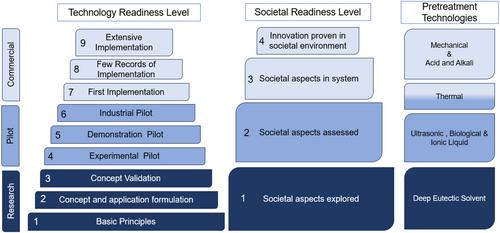下载PDF
{"title":"Textile waste pretreatment for anaerobic digestion: a review and technology feasibility study","authors":"Naveenrajah Tharmarajah, Kaveh Shahbaz, Saeid Baroutian","doi":"10.1002/jctb.7728","DOIUrl":null,"url":null,"abstract":"<p>The increasing volume of textile waste in landfills and incineration poses severe environmental challenges. Waste valorisation of textile waste via anaerobic digestion (AD) is preferable, as it offers economic and environmental benefits, but it is hindered by textile complexity, necessitating effective pretreatment technologies to improve biogas production. This study aims to evaluate various pretreatment technologies for biogas production from textile fibres via AD. A weighted-scoring analysis (WSA) assessed pretreatment methods based on technical, economic, environmental and operational criteria. Hydrothermal pretreatment emerged as the most technically effective method, scoring 140 owing to its substantial methane enhancement. Economically, shredding was the most viable option, scoring 125, as a consequence of low capital and O&M cost. Environmentally, hydrothermal and deep eutectic solvent (DES) pretreatments were top performers with 100 points owing to low environmental impact and positive heat reactions. In a case study conducted in the Auckland region, the potential environmental impact (PEI) obtained from hydrothermal and DES were 169 and 92 per year, respectively, resulting in minimal environmental impact. Operationally, ultrasonic and biological pretreatments scored highest owing to their ease of operation, and minimal health and safety requirements. Overall, hydrothermal pretreatment achieved the highest WSA score of 340, reflecting its balanced performance across all criteria. Hydrothermal pretreatment is the most promising technology for enhancing biogas production from textile waste. Its technical efficiency, economic feasibility and environmental benefits regarding the WSA score make it suitable for upscaling and providing a viable solution for managing textile waste in the AD plant. © 2024 The Author(s). <i>Journal of Chemical Technology and Biotechnology</i> published by John Wiley & Sons Ltd on behalf of Society of Chemical Industry (SCI).</p>","PeriodicalId":15335,"journal":{"name":"Journal of chemical technology and biotechnology","volume":"99 11","pages":"2213-2227"},"PeriodicalIF":2.8000,"publicationDate":"2024-08-21","publicationTypes":"Journal Article","fieldsOfStudy":null,"isOpenAccess":false,"openAccessPdf":"https://onlinelibrary.wiley.com/doi/epdf/10.1002/jctb.7728","citationCount":"0","resultStr":null,"platform":"Semanticscholar","paperid":null,"PeriodicalName":"Journal of chemical technology and biotechnology","FirstCategoryId":"5","ListUrlMain":"https://onlinelibrary.wiley.com/doi/10.1002/jctb.7728","RegionNum":4,"RegionCategory":"生物学","ArticlePicture":[],"TitleCN":null,"AbstractTextCN":null,"PMCID":null,"EPubDate":"","PubModel":"","JCR":"Q3","JCRName":"BIOTECHNOLOGY & APPLIED MICROBIOLOGY","Score":null,"Total":0}
引用次数: 0
引用
批量引用
Abstract
The increasing volume of textile waste in landfills and incineration poses severe environmental challenges. Waste valorisation of textile waste via anaerobic digestion (AD) is preferable, as it offers economic and environmental benefits, but it is hindered by textile complexity, necessitating effective pretreatment technologies to improve biogas production. This study aims to evaluate various pretreatment technologies for biogas production from textile fibres via AD. A weighted-scoring analysis (WSA) assessed pretreatment methods based on technical, economic, environmental and operational criteria. Hydrothermal pretreatment emerged as the most technically effective method, scoring 140 owing to its substantial methane enhancement. Economically, shredding was the most viable option, scoring 125, as a consequence of low capital and O&M cost. Environmentally, hydrothermal and deep eutectic solvent (DES) pretreatments were top performers with 100 points owing to low environmental impact and positive heat reactions. In a case study conducted in the Auckland region, the potential environmental impact (PEI) obtained from hydrothermal and DES were 169 and 92 per year, respectively, resulting in minimal environmental impact. Operationally, ultrasonic and biological pretreatments scored highest owing to their ease of operation, and minimal health and safety requirements. Overall, hydrothermal pretreatment achieved the highest WSA score of 340, reflecting its balanced performance across all criteria. Hydrothermal pretreatment is the most promising technology for enhancing biogas production from textile waste. Its technical efficiency, economic feasibility and environmental benefits regarding the WSA score make it suitable for upscaling and providing a viable solution for managing textile waste in the AD plant. © 2024 The Author(s). Journal of Chemical Technology and Biotechnology published by John Wiley & Sons Ltd on behalf of Society of Chemical Industry (SCI).
用于厌氧消化的纺织废物预处理:综述和技术可行性研究
垃圾填埋和焚烧产生的纺织废物数量不断增加,给环境带来了严峻的挑战。通过厌氧消化(AD)对纺织废弃物进行废物价值化是可取的,因为它具有经济和环境效益,但它受到纺织品复杂性的阻碍,需要有效的预处理技术来提高沼气产量。本研究旨在评估通过 AD 从纺织纤维中生产沼气的各种预处理技术。加权评分分析法(WSA)根据技术、经济、环境和操作标准对预处理方法进行了评估。热水解预处理是技术上最有效的方法,得分 140 分,因为它能大量增加甲烷。在经济上,粉碎是最可行的选择,得分为 125 分,因为资本和运营及维护成本较低。在环境方面,水热法和深共晶溶剂(DES)预处理法因对环境影响小和热反应积极而表现最佳,得分为 100 分。在奥克兰地区进行的一项案例研究中,水热法和 DES 每年对环境的潜在影响(PEI)分别为 169 分和 92 分,对环境的影响极小。在操作方面,超声波预处理和生物预处理得分最高,因为它们易于操作,对健康和安全的要求最低。总体而言,热液预处理的 WSA 得分最高,为 340 分,反映了其在所有标准中的均衡表现。热液预处理是最有希望提高纺织废料沼气产量的技术。它的技术效率、经济可行性和 WSA 分数方面的环境效益使其适合升级,并为厌氧消化(AD)工厂管理纺织废物提供了可行的解决方案。作者:© 2024。化学技术和生物技术期刊》由约翰威利和桑斯有限公司代表化学工业学会(SCI)出版。
本文章由计算机程序翻译,如有差异,请以英文原文为准。


